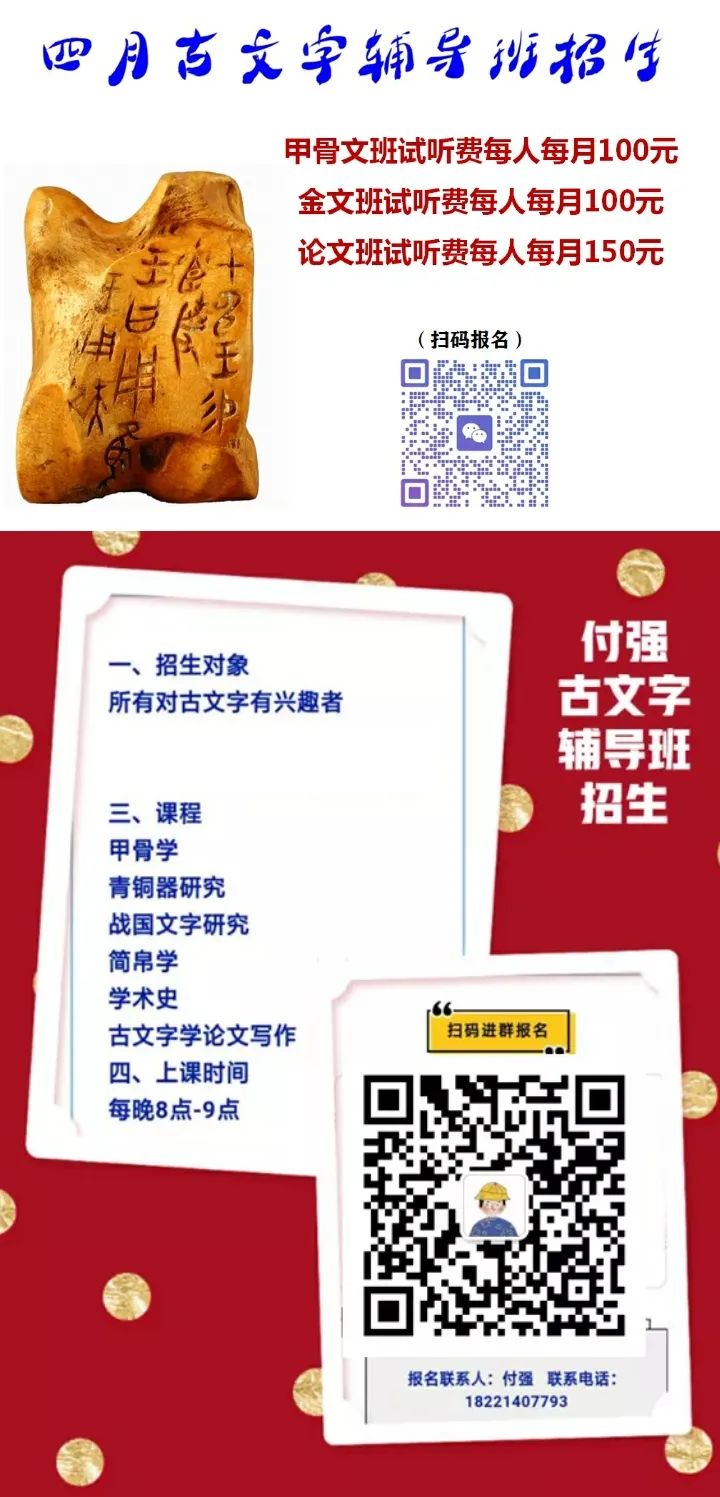How to express the essence of metal and stone
How to convey a sense of vastness and depth
Why not take a look at this plate
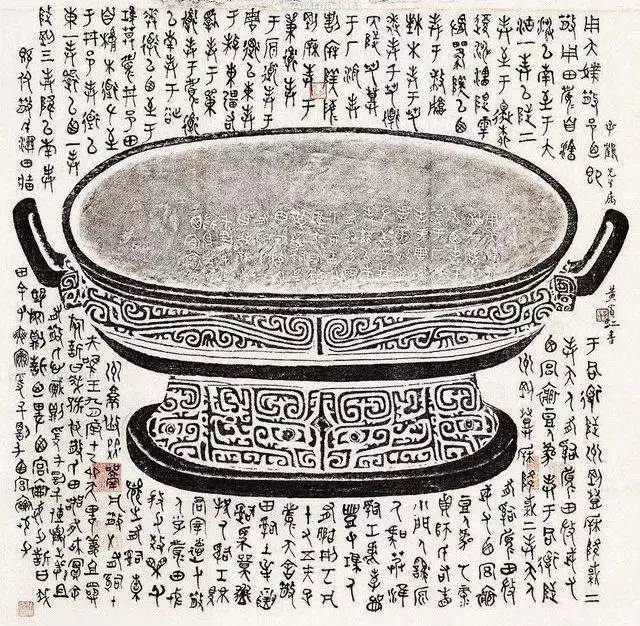
The San Family Plate (散氏盘), also known as the Plate of the Yao People, is a bronze artifact from the late Western Zhou Dynasty, named after the inscription containing the characters “San Shi”. It was excavated in the early years of the Qianlong reign in Fengxiang, Shaanxi (now Fengxiang County, Baoji City) and is currently housed in the National Palace Museum in Taipei. It is regarded as one of the “Four Great National Treasures of the Late Qing” (along with the Dayu Ding, the Maogong Ding, and the Guo Jizi White Plate).
The San Family Plate features an inscription structure that is uniquely ancient, with smooth and refined lines. The characters are hastily written and flat in form, with a tilted posture that appears both ancient and lively, marking the beginning of the “Cursive Seal” style. Due to its horizontal orientation and low center of gravity, it appears even more solid and substantial. Its strong sense of “casting” conveys a rich “metallic flavor”, thus holding an important position in the study of inscriptions. Calligrapher Hu Xiaoshi commented: “The seal script reached its peak during the Zhou Dynasty, with great vessels like the Dayu Ding and the Maogong Ding… The characters are arranged vertically, while the only one that maintains a horizontal style is the San Family Plate.”
The primary material for Western Zhou calligraphy is the bronze inscriptions, and the entire Western Zhou period can be considered the peak of bronze inscription development. The evolution of Western Zhou inscriptions transitioned from the bizarre and rugged to the elegant and harmonious, gradually maturing. During this period, the heavy strokes of inscriptions completely disappeared, and the beauty of line forms became pure, with the shapes of characters appearing more free and lively. The inscription on the San Family Plate, as a robust and vigorous example of Western Zhou calligraphy, serves as an excellent model for learning the Great Seal script, and is regarded as a treasure of bronze inscriptions alongside the inscriptions of the Maogong Ding and the Dayu Ding.
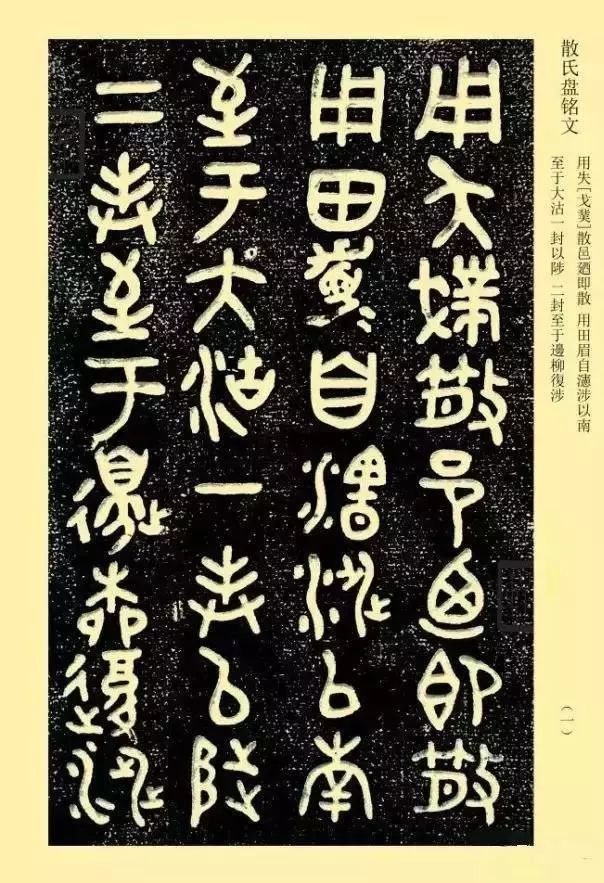
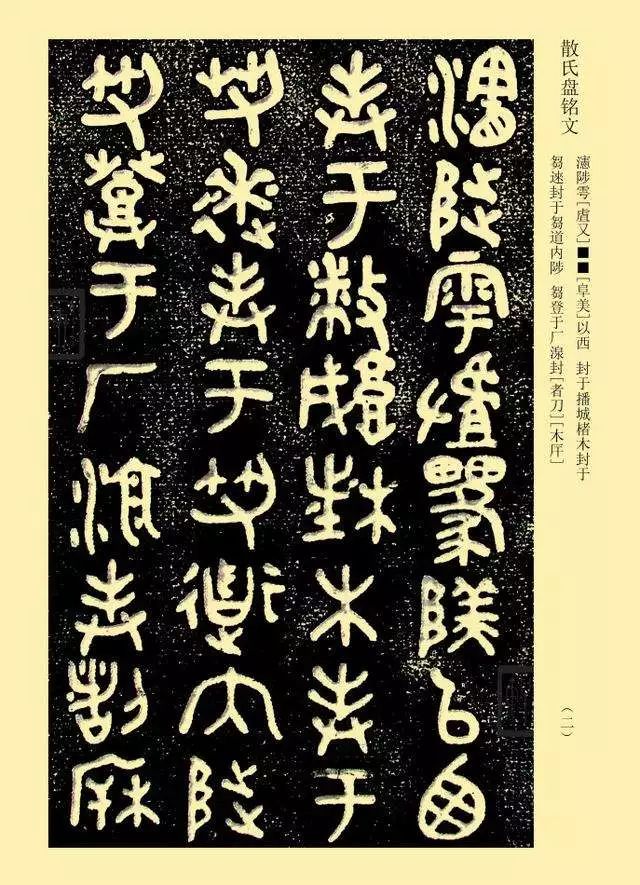
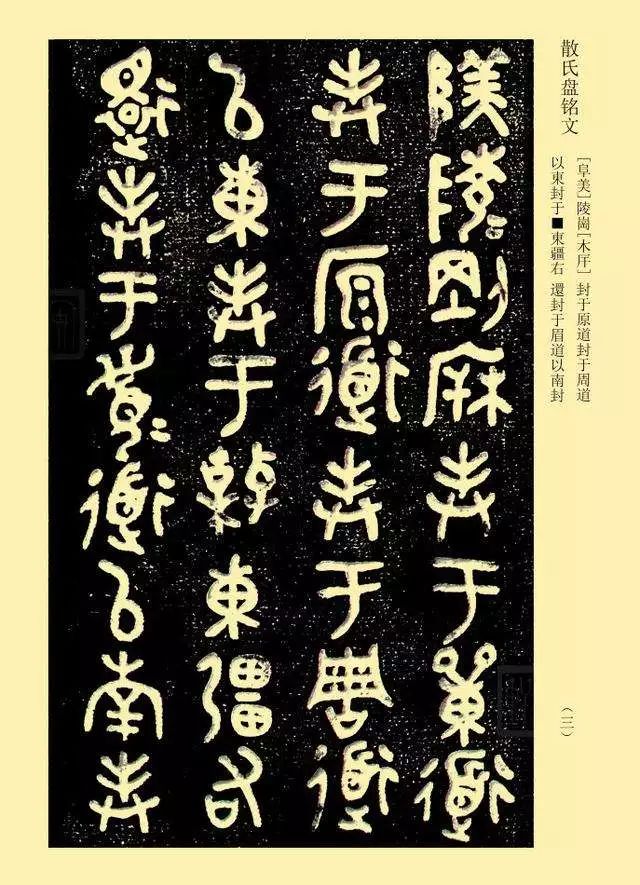
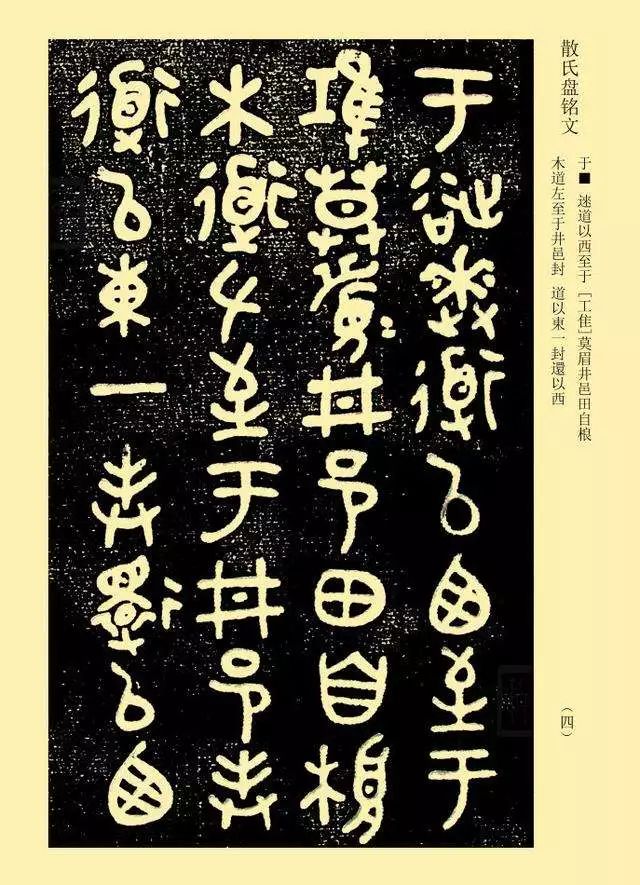
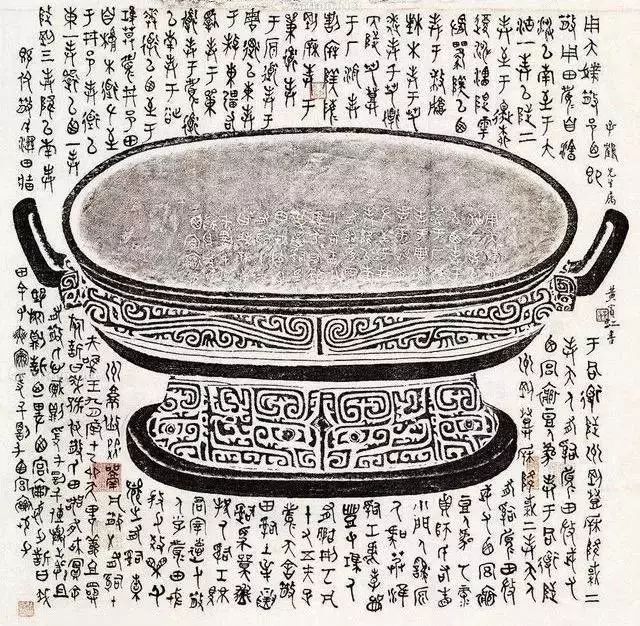
The San Family Plate, also known as the Plate of the Yao People, is a bronze artifact from the late Western Zhou Dynasty, named after the inscription containing the characters “San Shi”. It was excavated in the early years of the Qianlong reign in Fengxiang, Shaanxi (now Fengxiang County, Baoji City) and is currently housed in the National Palace Museum in Taipei. It is regarded as one of the “Four Great National Treasures of the Late Qing” (along with the Dayu Ding, the Maogong Ding, and the Guo Jizi White Plate).
The plate is 20.6 cm high and has a diameter of 54.6 cm. It is round, shallow, with double handles and a high ring foot. The belly is decorated with Kui patterns, and the ring foot features beast face patterns. The inner bottom is cast with an inscription of 19 lines and 357 characters. The content is a land transfer contract, detailing the land that the Yao people paid to the San family, including the boundaries and borders of the land, and the process of the oath ceremony. This is an important historical material for studying the land system of the Western Zhou Dynasty. The San state is located in the area of Fengxiang, Baoji, Shaanxi, and is adjacent to the Yao state to the northwest. Based on the characters mentioned in the inscription, it is inferred that the plate was cast during the reign of King Li of the Western Zhou.
The San Family Plate was collected by the public from the mid-Qianlong period until the 15th year of the Jiaqing reign, first being held by the Jiang family in Yangzhou for many years, and later passed to unknown hands.
In the winter of 1810, on the 50th birthday of Emperor Jiaqing, Alinbao presented the San Family Plate as a birthday gift to the emperor. The emperor rewarded him with the position of Governor of Jiangsu and Zhejiang. Thus, there is a saying in the antique community: “Ruan Yuan named the San Family Plate, and Alinbao presented the treasure to celebrate the birthday and was promoted.” Unlike Emperor Qianlong, Emperor Jiaqing did not have a strong passion for antiques, paintings, and jade. The San Family Plate entered the imperial treasury and was kept through the reigns of Jiaqing, Daoguang, Xianfeng, Tongzhi, Guangxu, and Xuantong, remaining hidden in the palace for a long time. Due to the long time, none of the six emperors appreciated it, leading to no one knowing where it was stored. After the burning of the Old Summer Palace in the tenth year of Xianfeng, it was rumored that the San Family Plate was destroyed in the fire. Thus, from the mouths of officials in the Imperial Household Department, it became known to antique dealers in Liulichang that “the San Family Plate is really gone, only a replica remains.”
One day in 1924, when the director of the Palace Museum, Ma Heng, was checking the items in the museum, he discovered a long-sealed wooden box, which contained the San Family Plate.
In the 13th year of the Republic of China, before Puyi left the palace, the Imperial Household Department checked the furnishings in the Yangxin Palace and found the San Family Plate hidden in the storeroom. After Puyi left the palace, the San Family Plate was collected by the Palace Museum. After the September 18 Incident, it was transferred from the Beijing Palace Museum to the National Palace Museum in Taipei.
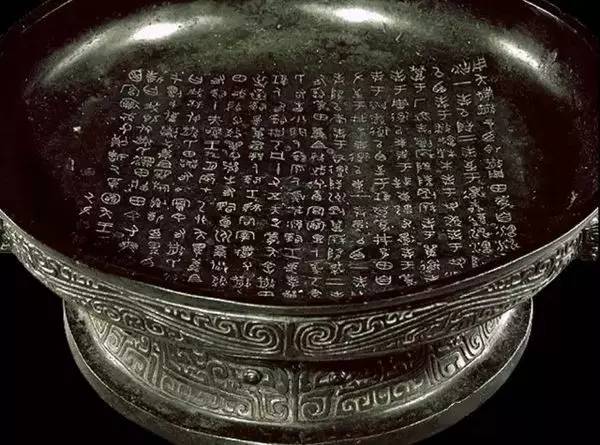
San Family Plate from the Western Zhou Dynasty, housed in the National Palace Museum, Taipei
The primary material for Western Zhou calligraphy is the bronze inscriptions, and the entire Western Zhou period can be considered the peak of bronze inscription development. The evolution of Western Zhou inscriptions transitioned from the bizarre and rugged to the elegant and harmonious, gradually maturing. During this period, the heavy strokes of inscriptions completely disappeared, and the beauty of line forms became pure, with the shapes of characters appearing more free and lively.
The inscription on the San Family Plate, as a robust and vigorous example of Western Zhou calligraphy, serves as an excellent model for learning the Great Seal script, and is regarded as a treasure of bronze inscriptions alongside the inscriptions of the Maogong Ding and the Dayu Ding.
The San Family Plate features an inscription structure that is uniquely ancient, with smooth and refined lines. The characters are hastily written and flat in form, with a tilted posture that appears both ancient and lively, marking the beginning of the “Cursive Seal” style. Due to its horizontal orientation and low center of gravity, it appears even more solid and substantial. Its strong sense of “casting” conveys a rich “metallic flavor”, thus holding an important position in the study of inscriptions. Calligrapher Hu Xiaoshi commented: “The seal script reached its peak during the Zhou Dynasty, with great vessels like the Dayu Ding and the Maogong Ding… The characters are arranged vertically, while the only one that maintains a horizontal style is the San Family Plate.”
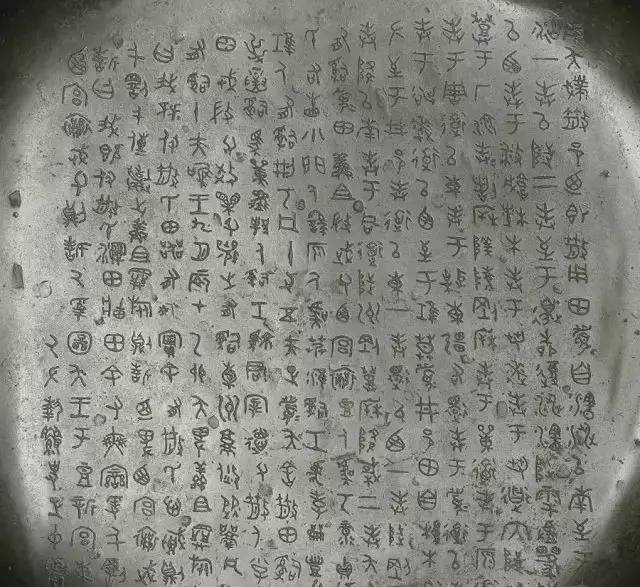
San Family Plate Inscription
The most significant aesthetic feature of the San Family Plate inscription is the word “clumsy”. It embodies simplicity, solidity, thickness, and strength, with thick and short strokes that present a mottled and natural beauty. The structure of the characters in the San Family Plate inscription is not fixed or rigid. Its vitality leaps off the page, yet it is naturally harmonious. Especially after the processes of casting and hammering, many of the long and short strokes no longer exhibit symmetry, uniformity, or parallelism, but instead reveal various irregularities and interests.
The use of round and blunt brushes in combination, yet round without weakness, blunt without stagnation, is the focus of the techniques in the San Family Plate inscription. In terms of structure, the character forms avoid being interesting without being frivolous, varied yet not contrived, with pearls and gems arranged beautifully, revealing exquisite details within a coarse texture. This is the charm of the San Family Plate inscription.
The inscription of the San Family Plate is bold and rugged in technique, yet not crude, but rather heavy and restrained, rich and grand. Its line quality perfectly harmonizes the naive with the sophisticated, the unrestrained with the steady, and the rough with the profound. It differs from the early inscriptions that often used thick strokes and dot clusters to embellish their forms, presenting a combination of lines and surfaces, and also differs from the later Zhou inscriptions that were deliberately neat. Instead, it reveals a playful beauty in its irregularity, giving a sense of artistic beauty that is both upright and lively. It can be said that the San Family Plate is both heavy and beautiful, yet also free and unrestrained.
The inscription of the San Family Plate, as a late Western Zhou text, presents a style characterized by a flattened structure. Within its square form, there is a round essence, breaking the conventions of symmetry and regularity in each character. It not only presents a horizontal tilt but also changes the usual right-high-left-low to left-high-right-low, with the character forms leaning towards the lower right. However, the posture is natural and unpredictable, with inter-character responses that arise from the context, and the character forms expand, full of interest. In the midst of simplicity and thickness, it adds a sense of strength, making it appear broad and generous, giving a sense of vitality. At the same time, the center of gravity of the characters shifts left and right, creating a noticeable sense of leap in each line. Coupled with its varied structure, it connects the characters and lines through a dynamic interplay of upward and downward, left and right, creating a sense of fluidity and elegance.
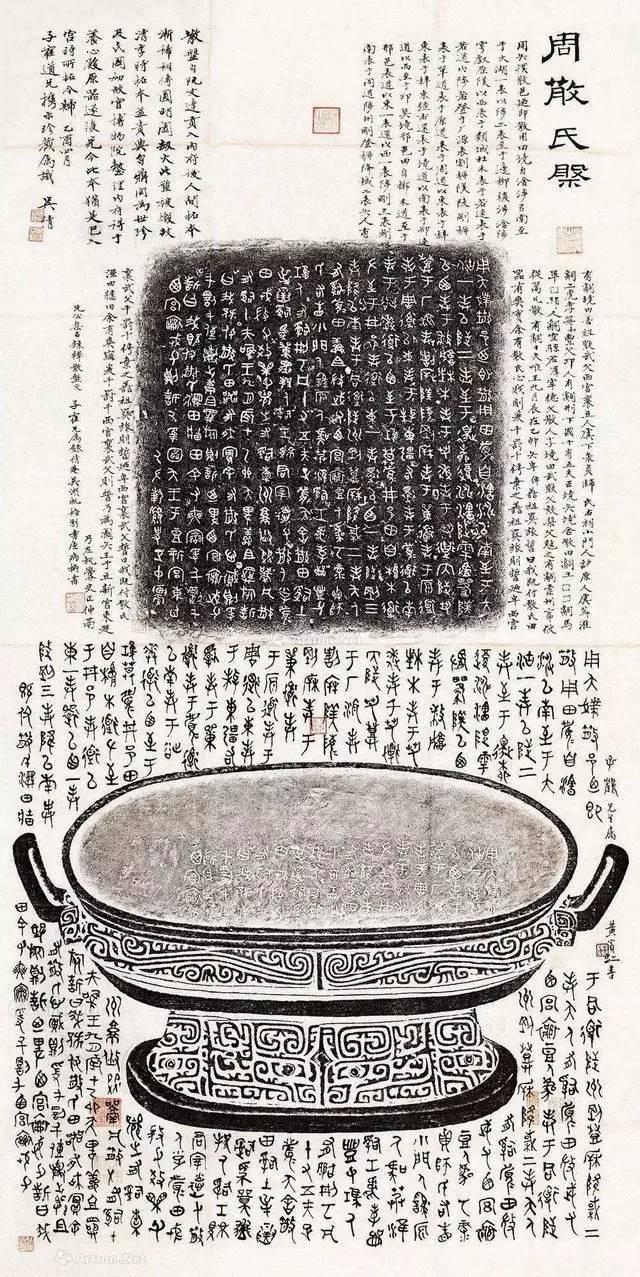
Zhou San Family Plate Rubbing, Wu Hufan’s Inscription, Shanghai Jiahe Spring Auction 2015, Sold for 1.15 million yuan
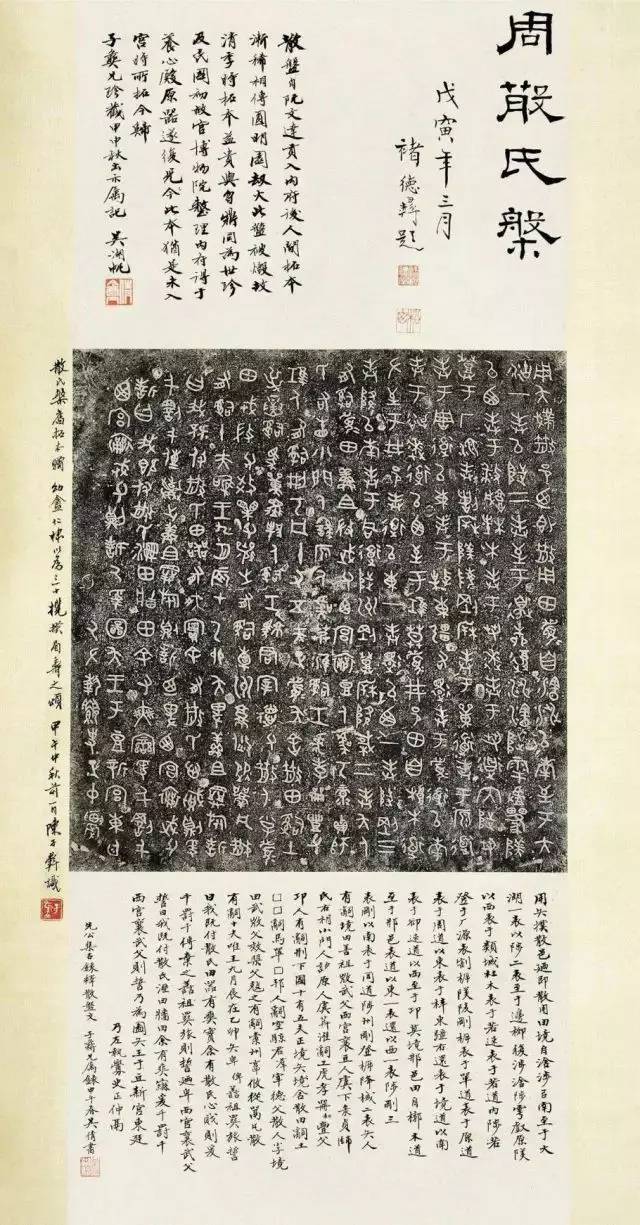
Huang Binhong’s Work on the San Family Plate, Jia De 2014, Sold for 184,000 yuan
Inscription
Using the Yao people to transfer land, thus the San family uses the land. From the river south to the Dagu, one offering. To the north, two offerings, to the boundary of Liu, and back to the river, ascending. To the west, offering to the broken city. To the mulberry tree, offering to the grass, offering to the grass path, ascending to the factory, offering to the mountains, the ridge, and the strong. Offering to the single path, sealing the original path, sealing the surrounding path. To the east, offering to the strong east. Returning to the path. To the south, offering to the grass path. To the west, to Mo. From the well to the land. From the left of the wooden path to the well, offering, to the east, one offering, returning, to the west, one offering, ascending three offerings. Descending to the south, offering to the same path. Ascending to the strong, ascending, descending two offerings. The Yao people have officials to manage the land: Xian, Qie, Wufu, Xiang, Douren, Yu, Lu, Shi, and others, a total of fifteen men. The San family officially manages the land: the soil officer, the horse officer, the official engineer, the father of virtue; the San family children manage the land: Rong, (Wei) father, teaching father, Xiang’s officials, Zhou, and others, a total of ten men. Only the king in September, the day of the rabbit, the Yao people, Xian, and Qie swore, saying: “Since I have given the San family land, if there is a violation, I will be punished a thousand times, and I will abandon it.” Xian and Qie then swore. Thus, the Xiang and Wufu swore, saying: “Since I have given the San family wet land and boundary land, if there is a violation, I will be punished a thousand times.” The Xiang and Wufu then swore. The king of the Yao people at the eastern court of Douxin Palace. The left holds the historian in the center of the farmer.
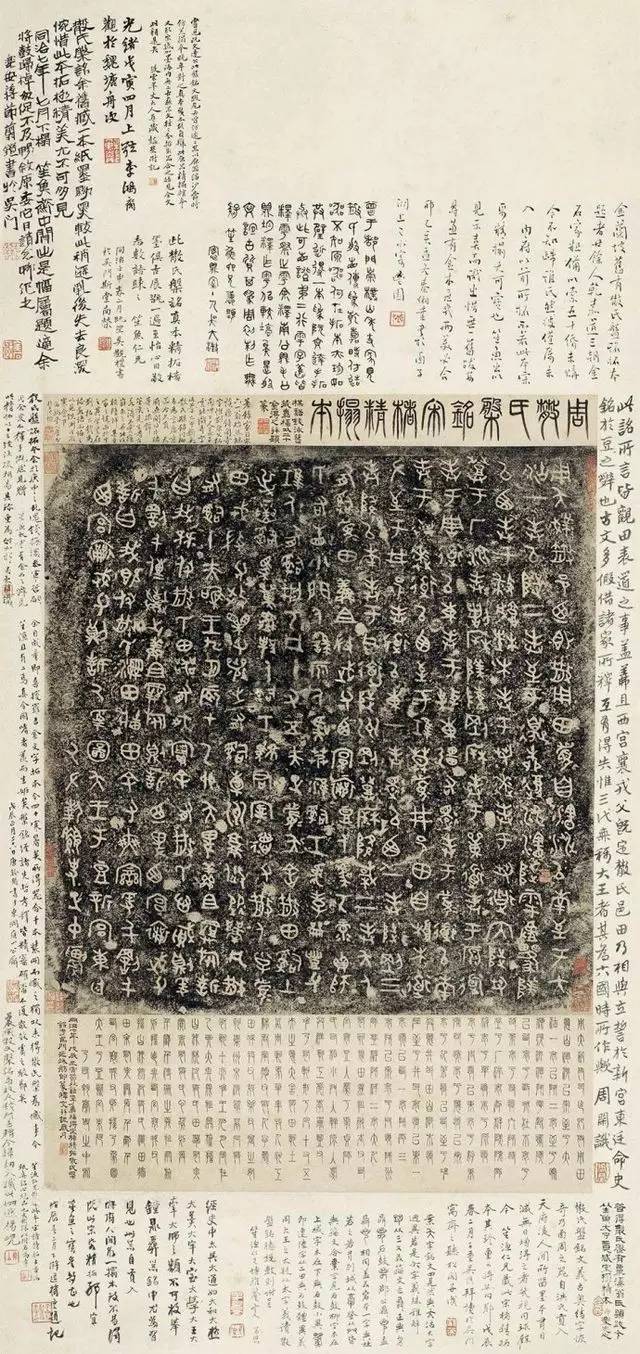
Old Rubbing of the San Family Plate Inscription, Eastern Grand View Spring Auction 2015, Sold for 4.255 million yuan
This rubbing was returned after being confiscated during the Cultural Revolution. Old collections of Qian Yong, Li Jiafu, and others, with inscriptions by Wang Yirong, Wu Dacheng, Wu Yun, Yang Xian, and others.
Collector’s Introduction
1. Wu Yun (1811–1883), courtesy name Shaoqing, also known as Shaofu, with the nickname Pingzhai, later known as Tuilou, and other names such as Zui Shi and Erbai Lantingzhai, was from Huzhou, Zhejiang. He was a Jinshi and served as the governor of Zhenjiang and Suzhou, deeply studying archaeology, and once collected two hundred versions of the Lanting Xu and two Qi Hou Lei. He was skilled in calligraphy and printing, and was a noted scholar and connoisseur of the Qing Dynasty.
2. Guo Wenbin (1811-1889), courtesy name Weiru, also known as Zishan, Zishan, with the nickname Genzhai, Genan, Guoyunlou, Tui’an, and Yiyuan, was from Yuanhe (now Suzhou, Jiangsu). He was a successful candidate in the imperial examination in the 21st year of Daoguang and served as the governor of Ning and Shao in Zhejiang. He was skilled in calligraphy, poetry, and had a rich collection, being a famous collector. His descendants donated a total of 308 pieces of Song, Yuan, Ming, and Qing paintings and calligraphy from the Guoyunlou collection to the Shanghai Museum in 1951 and 1959.
3. Xu Kang (1814-?), courtesy name Zijin, with the nickname Yusou, was from Suzhou, Jiangsu. He was skilled in poetry, painting, seal carving, and especially in identifying paintings and calligraphy, and had a work titled “Qianchen Mengying Lu”.
4. Tang Han (1816-1896), courtesy name Zibing, with the nickname Jiao’an, Wenbo, Yanshishanchang, and other names such as Weizimianzhai and Tiexiruyi, was from Jiaxing, Zhejiang. He was a successful candidate in the imperial examination and served as the county magistrate of Suzhou. He was skilled in identifying and collecting inscriptions, paintings, and calligraphy, and could paint flowers and calligraphy.
5. Zhou Xian (1820-1875), courtesy name Cunbo, also known as Xiaoyuan, with the nickname Fanhuju, was from Xiushui (now Jiaxing, Zhejiang) and lived in Shanghai. He served as the magistrate of Xinyang in the early Tongzhi period. He was skilled in flowers and seal carving and was one of the sixty famous figures in Shanghai.
6. He was friendly with Weng Tonghe.
7. Wu Guanli (?-1878), courtesy name Zijun, with the nickname Gui’an, was from Yuhang, Zhejiang. He was a successful candidate in the imperial examination in the 10th year of Tongzhi, served as an editor, and reached the position of deputy governor in Shaanxi. In the second year of Guangxu, he was the deputy examiner of the Sichuan provincial examination. He authored the “Gui’an Writings”.
8. Li Hongyi (1831-1885), courtesy name Meisheng, with the nickname Xiangyan, Sulin, and Ranjian, was from Zhongjiang, Sichuan. He was a successful candidate in the Xianfeng examination and served as the inspector of Jiangsu, later moving to Suzhou. He was skilled in poetry, prose, calligraphy, and ancient texts.
9. Li Jiafu (1839-1904), courtesy name Leping, with the nickname Shengyu, and another name Beixi, with the studio name Yinian Pavilion, was from Shimen, Zhejiang (now Chongde). He was the father-in-law of Wu Daiqiu. He was skilled in calligraphy and painting, with a rich collection.
10. Wang Yirong, courtesy name Zhengru, also known as Liansheng, Liansheng, with the nickname Guxian Village Man, Yangqian Jushi, was from Fushan, Shandong. He was a successful candidate in the sixth year of Guangxu, served as an editor, and was appointed to oversee the provincial examination in Henan. He was later promoted to the position of reader at the Imperial Academy. He studied under Zhang Zhidong and was skilled in calligraphy and the study of inscriptions.
Inscription:
Once saw the inscription of this plate by Ruan Wenda, which said: I once imitated two vessels, using the original vessel to make a sand mold. At that time, the imitation vessel was a copy, and in my later years, I could hardly distinguish the true from the false. This original vessel is a fine copy, and I used Song paper and ink. There are no two ancient vessels like this in the world. The text is often divided into several vessels, and this is the first time I have seen the full text of this kind.
In the fourth month of the fifth year of Guangxu (1878), I observed it on a boat in Weitang, Li Hongyi.
In the 7th year of Tongzhi (1868), I stayed at Shengyu Pavilion and casually wrote this inscription. I was about to return to the boat, and I was in a hurry and could not elaborate on the details. I will ask for a record of this later. Jiang Jie wrote this in Wumen.
This inscription is a true copy of the San Family Plate, with both paper and ink being ancient. After reading it once, it is pleasing to the heart and eyes, and I respectfully inscribe a few words. Brother Shengyu. In the spring of the year of Wujin (1872), I wrote this in Wumen.
Once in the capital, I saw the San Family Plate, which was said to be a replica made during the Qianlong and Jiaqing periods, but I do not know where the original vessel is. The rubbing is also precious, as I recently obtained a copy made by Ruan Wenda. This can verify that the second line of the text is old and can be interpreted as such. I have interpreted the Nanguo Ding and the Maogong Ding, and they seem to be more accurate than the San Family Plate inscription. Brother Shengyu wrote this inscription.
In the past, I had a rubbing of the San Family Plate, which was given to me by my late friend Qian Shuge. Now I regret that it was lost in the fire. Yang Xian.
Brother Shengyu showed me this copy, which is a fine rubbing on Song paper, and is truly a rare piece. I am honored to have my name attached to it.
The inscription mentions the matters of the land transfer, which was established by the Yao people and Xiang, and the father had already determined the San family’s land, thus they swore an oath in the eastern court of the new palace, commanding the historian to inscribe it in the text of the Dou. Many ancient texts borrow from various families’ interpretations, with mutual gains and losses. Only the three dynasties did not refer to the great king, which was made during the time of the six states. Zhou Xian recognized this.
The San Family Plate inscription is a fine copy, with the old collection of Qian Yong and Li Jiafu, and the inscriptions by Wang Yirong and Wu Dacheng.
Ruan Yuan’s Hand-Copied San Family Plate Inscription
Spring Auction of Xiling Yinshe 2015
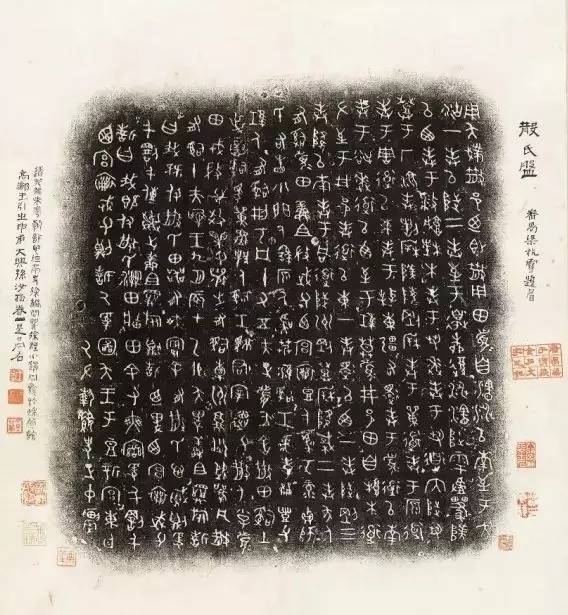
San Family Plate Inscription Rubbing, Kuangshi 2012 Spring Auction
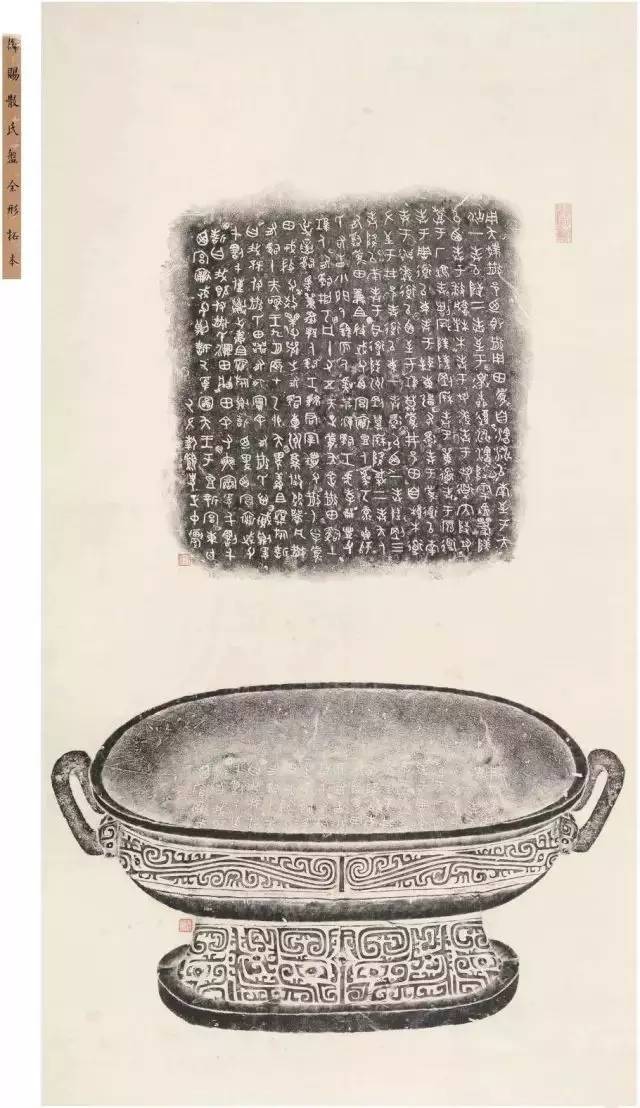
Imperial Gift of the Complete Rubbing of the San Family Plate
Eastern Grand View Spring Auction 2015
Sold for 1.127 million yuan
This is a late Qing Dynasty rubbing of the San Family Plate, one of the four great bronze treasures, made by Zhou Xiding. Puyi ordered Zhou Xiding to make fifty fine copies, stamped with the “Yangxin Palace Fine Appraisal Seal” and distributed to the court officials. This rubbing bears the stamps “Xiding Hand-Copied Inscriptions” and “Yangxin Palace Fine Appraisal Seal”, with the outer inscription stating it is the complete rubbing of the San Family Plate, a precious item distributed to the court officials by Puyi on that day, and has become a rare item today.
Collector’s Introduction
Zhou Xiding (1891-1961), also known as Kang Yuan, originally named Jiarui, was from Linchuan, Jiangxi. He lived in Beijing and worked in the field of ancient artifacts and cultural relics preservation and identification. He was also skilled in seal carving and published “Shiyan Pavilion Seal Collection” in the 1940s, collecting over a thousand seals. He made numerous fine rubbings of bronze, jade, oracle bones, coins, and stone inscriptions, and his rubbings are exquisite.

Rubbing of the San Family Plate Inscription, Wu Hufan’s Inscription
Duoyunxuan Spring Auction 2014
Sold for 1.4375 million yuan
Rubbing of the San Family Plate Inscription, Inscription by Weng Fanggang and Yi Bingxiu
Jia De Spring Auction 2015, Sold for 1.265 million yuan
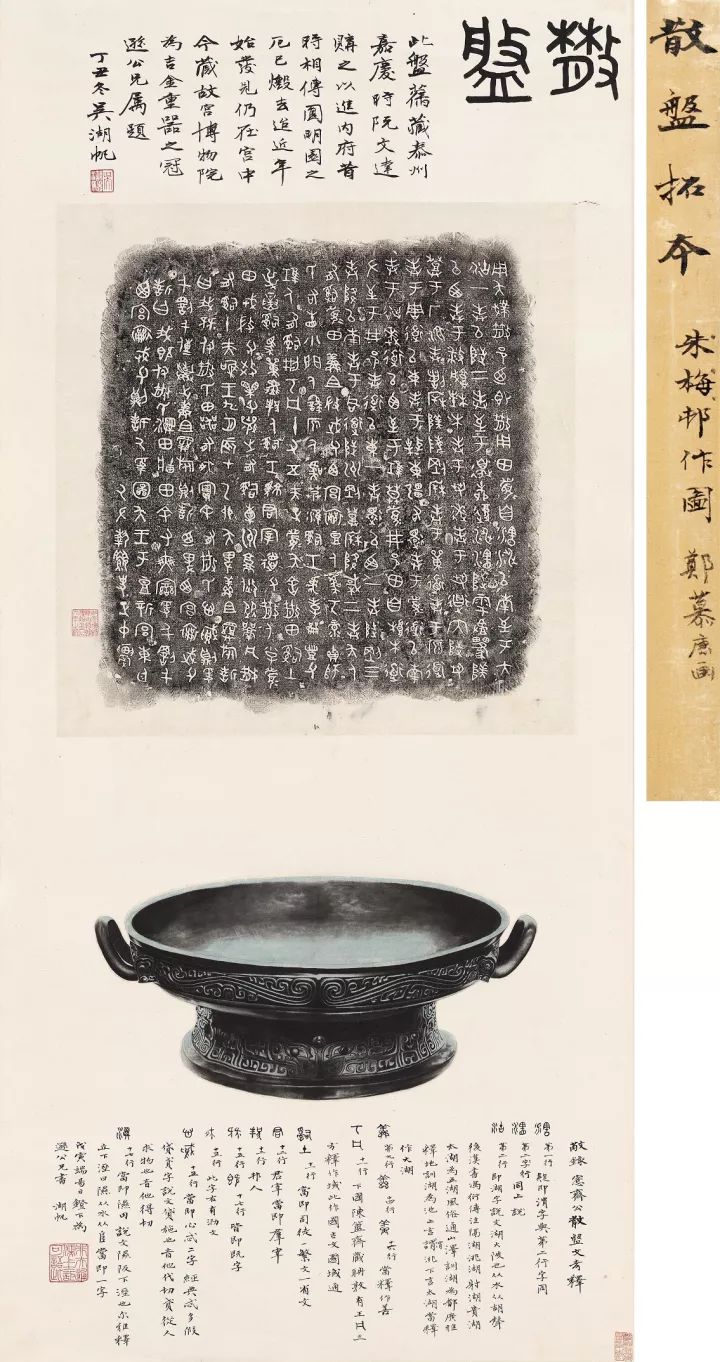
Wu Hufan’s Inscription on the San Family Plate Rubbing
And Zheng Mukang’s Painting of the Complete San Family Plate
Old Rubbing
1 axis 123×57cm
Recorded in: “Chou Yi Diary”, authored by Wu Hufan, included in “Wu Hufan Manuscripts” p198, China Academy of Art Press, 2004.
Published in: “Ink” magazine, issue 44, p99, Art News Agency.
Note: Wu Hufan’s inscription and Wu Dacheng’s interpretation of the San Family Plate are recorded. Old collection of Duoyunxuan.
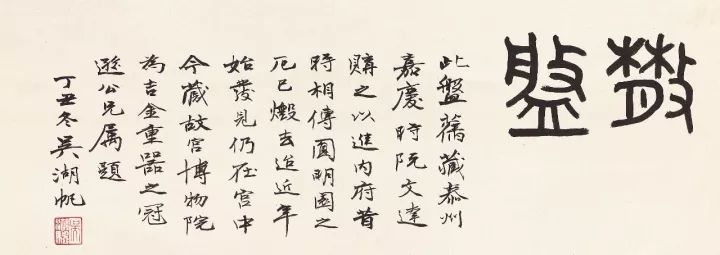
Inscription 1
The San Family Plate. This plate was previously collected in Taizhou, purchased by Ruan Wenda during the Jiaqing period to present to the imperial treasury. It was once said that the misfortune of the Old Summer Palace had destroyed it, but in recent years it has been seen to still be in the palace. It is now housed in the Palace Museum, regarded as the crown of ancient bronze vessels. Brother Xun Gong’s inscription, written in the winter of the Dingchou year by Wu Hufan.
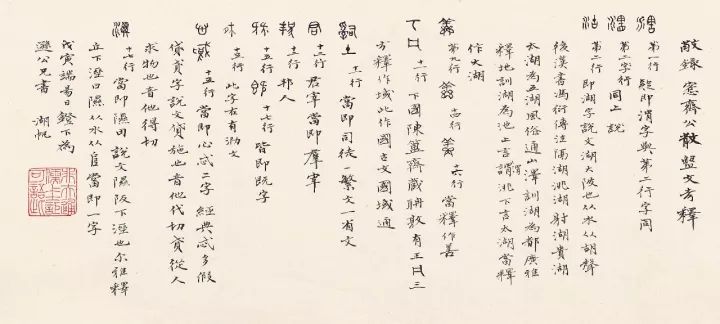
Inscription 2
Respectfully recorded the interpretation of the San Family Plate by Gong Zhi (briefly). On the day of the Dragon Boat Festival in the year of Wujin, I wrote this under the lamp. Hufan.
Source: Guofeng Art Online
